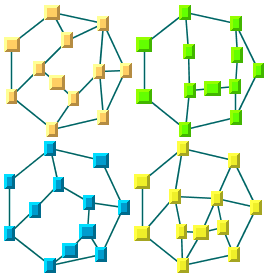Laying out connected components of a disconnected graph
Rogue Wave®
JViews Diagrammer provides special support for the layout of a
disconnected graph.
If a graph is composed of several
connected components or contains isolated nodes (nodes without any links), it can be desirable to apply the layout algorithm separately on each connected component and then to position the connected components using a specialized layout algorithm (usually,
IlvGridLayout). The following figure shows an example of a graph containing four connected components. By enabling the layout of the connected components on the regular layout instance (here,
IlvTopologicalMeshLayout), the connected components are automatically identified and laid out individually. Finally, the four connected components are positioned using a highly customizable placement algorithm (
IlvGridLayout).
Automatic layout of connected components in a disconnected graph
To indicate whether a subclass of IlvGraphLayout supports this feature, use the method in the class IlvGraphLayout:
boolean supportsLayoutOfConnectedComponents()
The default implementation returns false. A subclass can override this method in order to return true to indicate that this feature is supported.
In Rogue Wave JViews Diagrammer you can enable the layout of the connected components by using the method:
void setLayoutOfConnectedComponentsEnabled(boolean enable)
To obtain the current setting:
boolean isLayoutOfConnectedComponentsEnabled()
The default value is the value returned by the following method:
boolean isLayoutOfConnectedComponentsEnabledByDefault()
The default implementation of this method in
IlvGraphLayout returns
false. For some of the layout classes, it is appropriate that this feature is enabled by default. Therefore
IlvUniformLengthEdgesLayout overrides this method to return
true.
If enabled on a layout class that supports this feature, the method performLayout of the class IlvGraphLayout cuts the attached graph model into connected components and lays out each connected component separately.
How does the layout of connected components feature work when this mechanism is enabled in the layout classes that support this feature? Instead of directly calling the method
layout to perform the layout on the entire graph, the method
performLayout first cuts the graph into connected components.
Then, each connected component is laid out separately by a call of the method layout. To do so, the attached graph is temporarily changed into internally generated graphs corresponding to each of the connected components of the original graph.
Finally, the layout instance returned by the method:
IlvGraphLayout getLayoutOfConnectedComponents()
is used to position the connected components. To specify the layout instance that places the connected components, use the following method:
void setLayoutOfConnectedComponents(IlvGraphLayout layout)
If no layout instance is specified using this method, the method
getLayoutOfConnectedComponents returns an instance of
IlvGridLayout. Its layout region parameter is set by default to the rectangle (
0,
0,
800,
800 ). Its “layout mode” parameter is set to
TILE_TO_ROWS.
NOTE The Tree, Hierarchical, and Circular layouts contain built-in support for disconnected graphs. For the Tree and Hierarchical layouts, the result can be different from the result of the generic mechanism (the layout of connected components feature) provided by the base class
IlvGraphLayout. Depending on your particular needs, you can use either the generic mechanism or the built-in support.
Copyright © 2018, Rogue Wave Software, Inc. All Rights Reserved.
